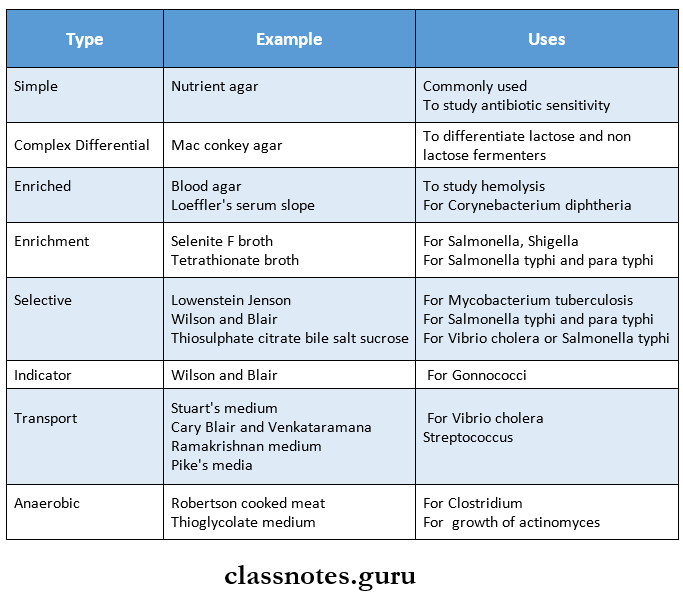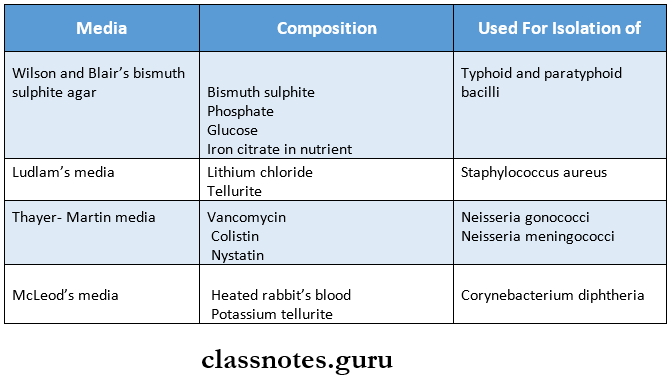Culture Media And Culture Methods Important Notes
1. Culture Media

Read And Learn More: Microbiology Question and Answers
2. Common Culture Media Used In Mycology
- Sabouraud’s agar
- Cornmeal agar
3. Czapek – Dox
- Anaerobic culture method
- Obtained by McIntosh and Flide’s anaerobic jar
- It is the most reliable and widely used method
Culture Media And Culture Methods Long Essays
Question 1. Define and classify cultural media with examples. Write briefly on selective and anaerobic media.
Answer:
Culture Media
The culture media are the bacteriological media used for isolation and characterization of various bacterial pathogens
Cultural Media Classification: Cultural media are classified as:
Selective Media:
- They are solid media which contain a substance incorporated into it
- It has a selective stimulating effect on the bacteria to be grown and an inhibitory effect on the growth of the unwanted bacteria
- They enable a greater number of the required bacteria to form colonies
- They are used to isolate a particular bacteria from specimens

Anaerobic Media:
- These media are used to grow the anaerobic organism
- They contain a reducing agent that absorbs all the oxygen and creates an anaerobic condition favouring the growth of anaerobes

Question 2. Classify culture media. Describe anaerobic culture methods.
(or)
McIntosh and Filde’s anaerobic jar
Answer:
Anaerobic Culture Methods:
1. Cultivation In Vacuum.
- Anaerobic chamber (or) cabinets (or) glove boxes
- Anaerobic bags (or) pouches
2. Displacement Of Oxygen With Gases Like Hydrogen, Nitrogen, And Helium. Candle jar method.
3. Absorption Of Oxygen.
- Chemical Methods
- Alkaline pyrogallol method.
- Spray anaerobic dish
- Ordinary petri dish.
- Buchner’s tube
- Rosenthal method
- Phosphoprous stick method.
- Alkaline pyrogallol method.
- Biological Methods.
4. Me Intosh Filde Anaerobic Jar
- It is the most widely used anaerobic method
- It consists of a glass or metal jar with a metal lid that can be clamped down on a gasket to make it airtight with a screw clamp
- The lid has two tubes with taps, one is a gas inlet and the other is an outlet
- One or more capsules containing palladiumized alumina pellets are suspended under the lid with wires and connected to electric terminals on the lid for heating
- Alternatively, a temperature catalyst called de-oxo pellets can be used
- Inoculated culture plates are placed in the jar with the medium in the bottom half of the plates and lids are clamped tight
- The production of anaerobic conditions is brought about by
- Displacement of oxygen
- Displacement and combustion of oxygen

5. Gaspak System
6. Reduction Of Oxygen.
- An aerobic media
- Example: Robertson’s cooked meat broth
- Thioglycollate medium
- Smith Noguchi medium.

Culture Media And Culture Methods Short Essays
Question 1. Enriched media
Answer:
Enriched Media
- This is a special medium,
- When a basal medium is added with some nutrients such as blood, serum (or) egg it is called an enriched medium.
- Enriched media = Basal media + some nutrients [blood, serum, egg]
Enriched Media Examples:
- Blood Agar:
- Blood agar – nutrient agar + blood
- Used for routine culture
- Example: streptococcus
- Mostly sheep blood 5 – 10% is used.
- Chocolate Agar:
- It is prepared by heating 10% sterile blood in sterile nutrient agar at 55oC for 2 hours.
- Used for the cultivation of Neisse via, Haemophilus influenza.
- Loeffler’s Serum Slope:
- It is composed of nutrient broth, glucose, and horse serum.
- Used for the cultivation of diphtheria, the core bacterium
- Dorset egg medium is used for the cultivation of diphtheria and tubercle bacilli.
Question 2. Mention three selective media with their uses
Answer:
Three Selective Media With Their Uses

Question 3. Robertson’s cooked meat media
Answer:
Robertson’s Cooked Meat Media It is an anaerobic culture media
Robertson’s Cooked Meat Media Composition: Composed of Nutrient broth, Predigested cooked meat of ox heart
Robertson’s Cooked Meat Media Uses:
- It is used for anaerobic culture
- For the preservation of the stock culture of the aerobic organism
- Valuable medium for preserving cultures of the delicate organism
- May be used as a recovery medium for spores
Culture Media And Culture Methods Short Answers
1. Blood agar
Answer:
Blood Agar
- Blood agar is an enriched media
- In it blood is added as a nutritive substance to the basal media
- Though the blood agar is enriched media, the bacteria lysing red cells show a dearing around the colonies
- It helps in the growth of bacteria
Question 2. Blood Culture
Answer:
Blood Culture
Blood culture is one of the most important investigations in clinical microbiology
Blood Culture Indications:
- Where there is a possibility of septicaemia or bacteriemia
- For diagnosis of pyrexia of unknown origin
Question 3. Transport media
Answer:
Transport Media
For the transport of specimens to the laboratory, special media are devised and these are termed as transport media.
Transport Media Examples:
1. Stuart’s Transport Medium:
- It is a non-nutrient soft agar gel containing a reducing agent to prevent oxidation and charcoal to neutralise bacterial inhibitors.
- It is used in organisms such as gonococci.
2. Buffered Glycerol Saline Transport Medium: Used for enteric bacilli.
Question 4. Enrichment media
Answer:
Enrichment Media
- Some substances are incorporated in the liquid medium which has a stimulating effect on the bacteria to be grown (or) inhibits its competitors.
- This results in an absolute increase in the number of wanted bacteria related to other bacteria. Such media are called enrichment media.
- They are very useful for the culture of faeces where foe non – pathogenic tend to overgrow than pathogenic ones.
- Example: Salmonella being overgrown by E. Coli.
Enrichment Media Examples:
1. Tetrathionate Broth:
- Composed of nutrient broth, Sodium thiosulphate, Calcium carbonate, and Iodine solution.
- Used for the culture of faeces, especially for salmonellae.
2. Selenite F Broth
- Composed of Peptone water and sodium selenite.
- For culture of Salmonellae, shigellae.
3. Alkaline Peptone Water: Peptone water at pH 9.0 was used for the culture of vibrio.
4. Robertson’s Cooked Meat Broth:
- Composed of Nutrient broth, Predigested cooked meat of ox heart.
- Used for the culture of anaerobic bacteria.
Question 5. Preparation of blood agar media
Answer:
Preparation Of Blood Agar Media
- Blood agar is prepared by adding 10 ml of defibrinated sheep blood to 100 ml of nutrient agar
- The sterile nutrient agar is melted by steaming and then the temperature is brought down to 45° C
- The required quantity of sheep blood is added aseptically with constant gentle shaking without froth formation
- The medium is immediately poured into the plates and allowed to set
Culture Media And Culture Methods Viva Voce
- Robertson cooked meat media is an anaerobic media
- Blood agar is an enriched media
- Loeffler serum slope is composed of nutrient broth, glucose and horse serum
